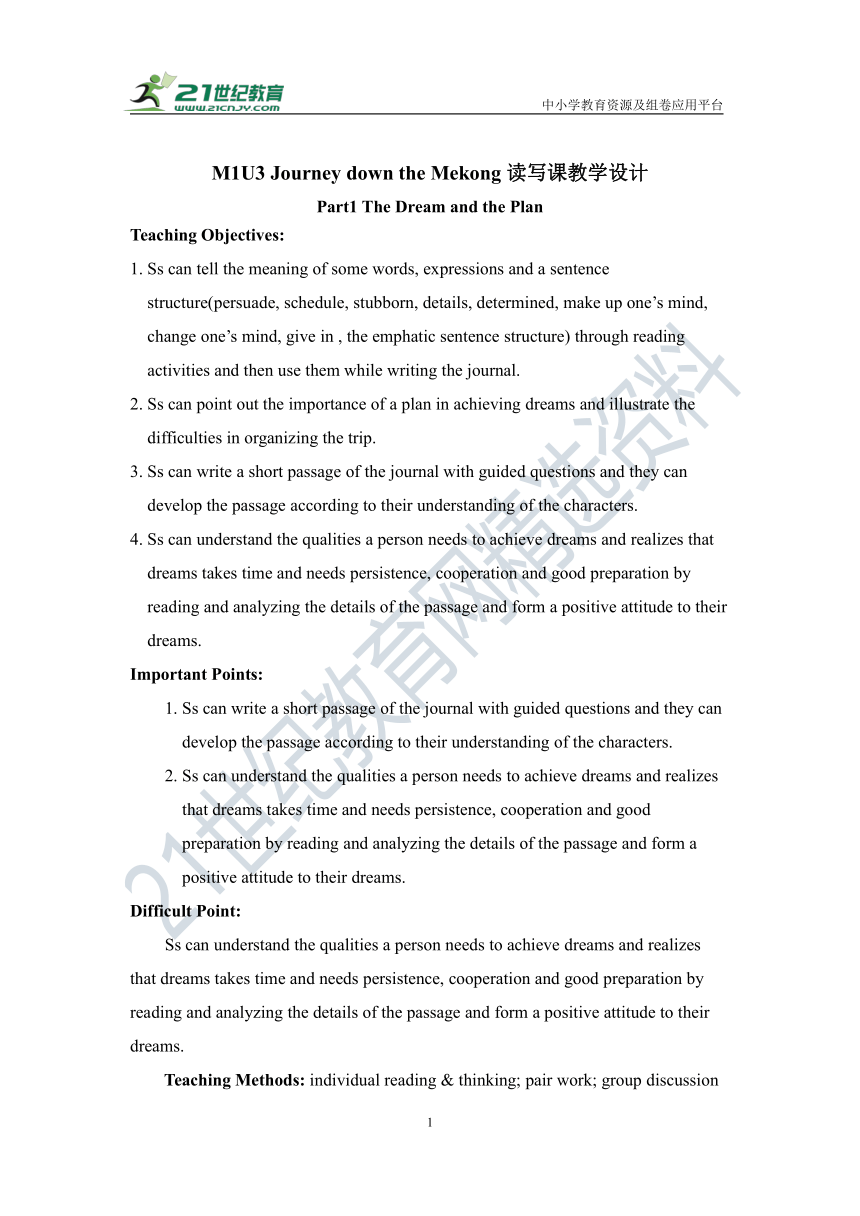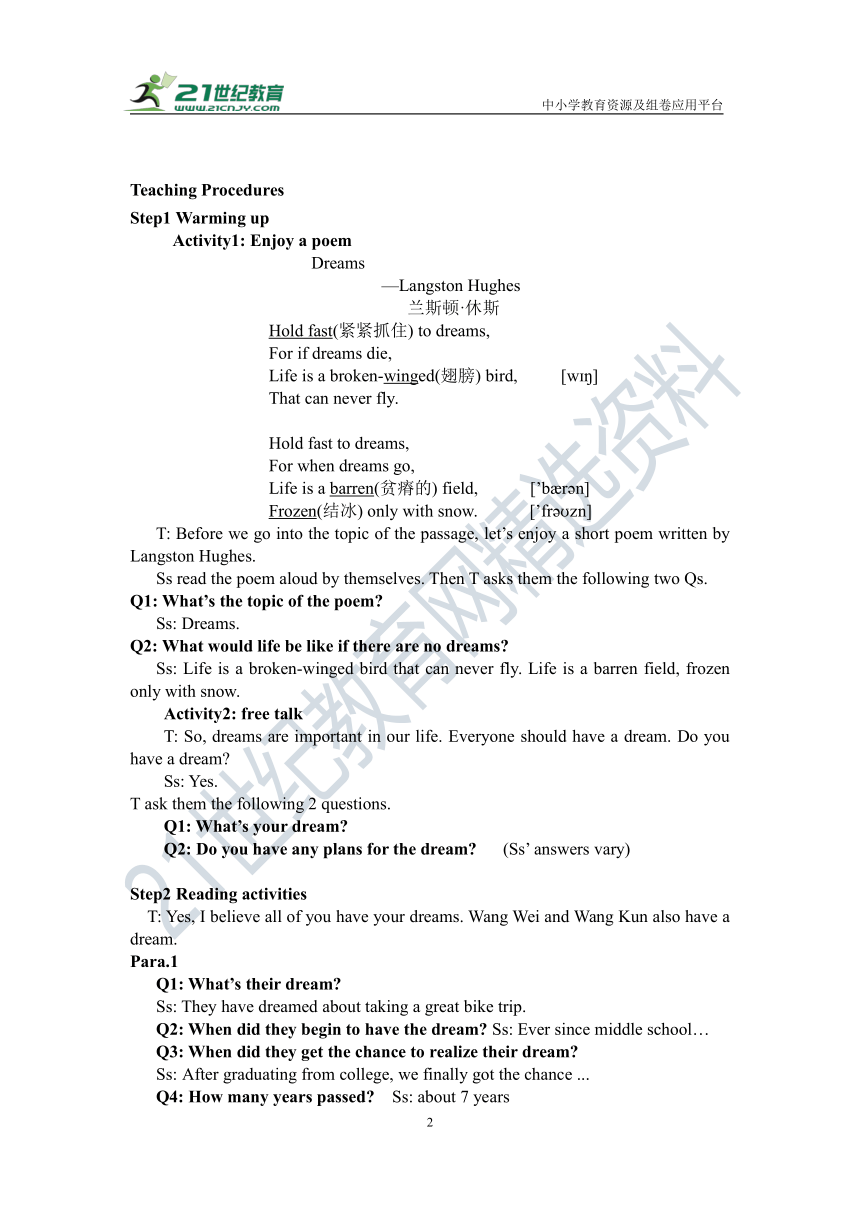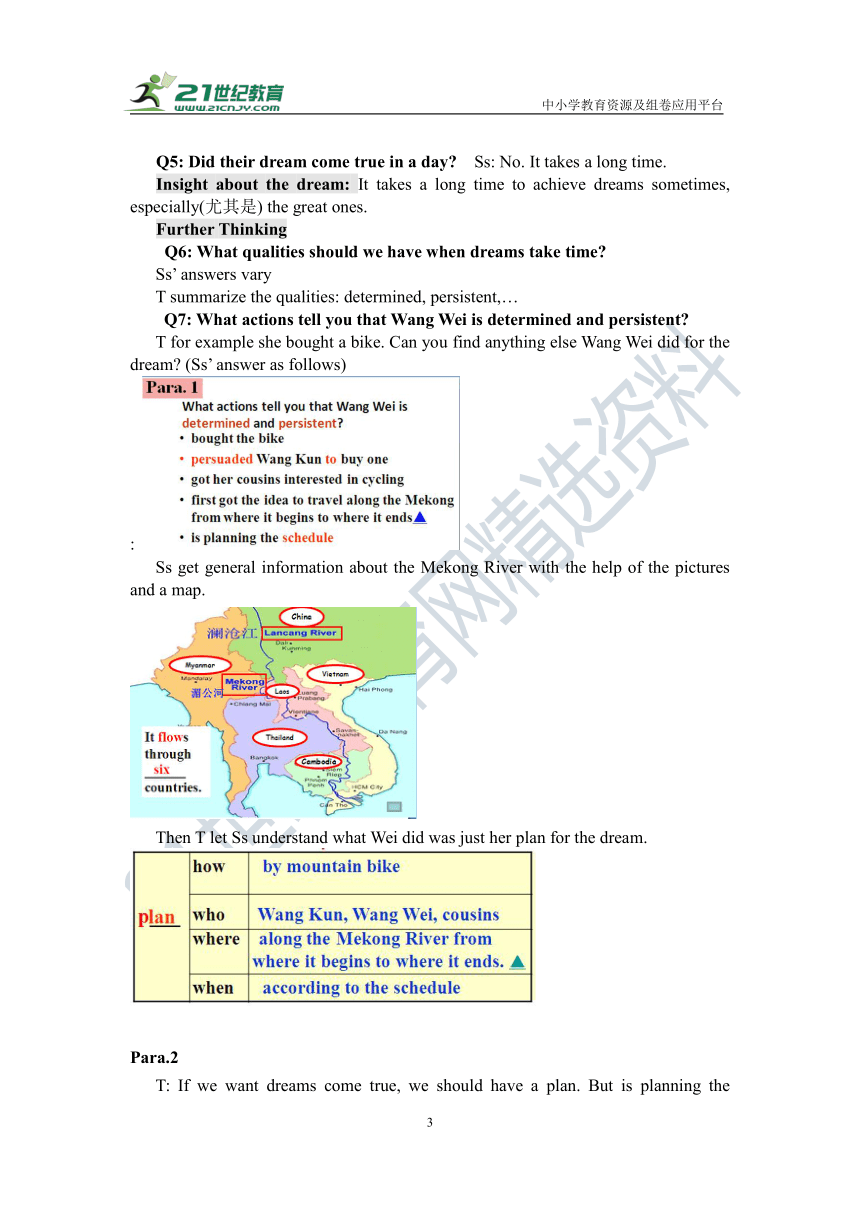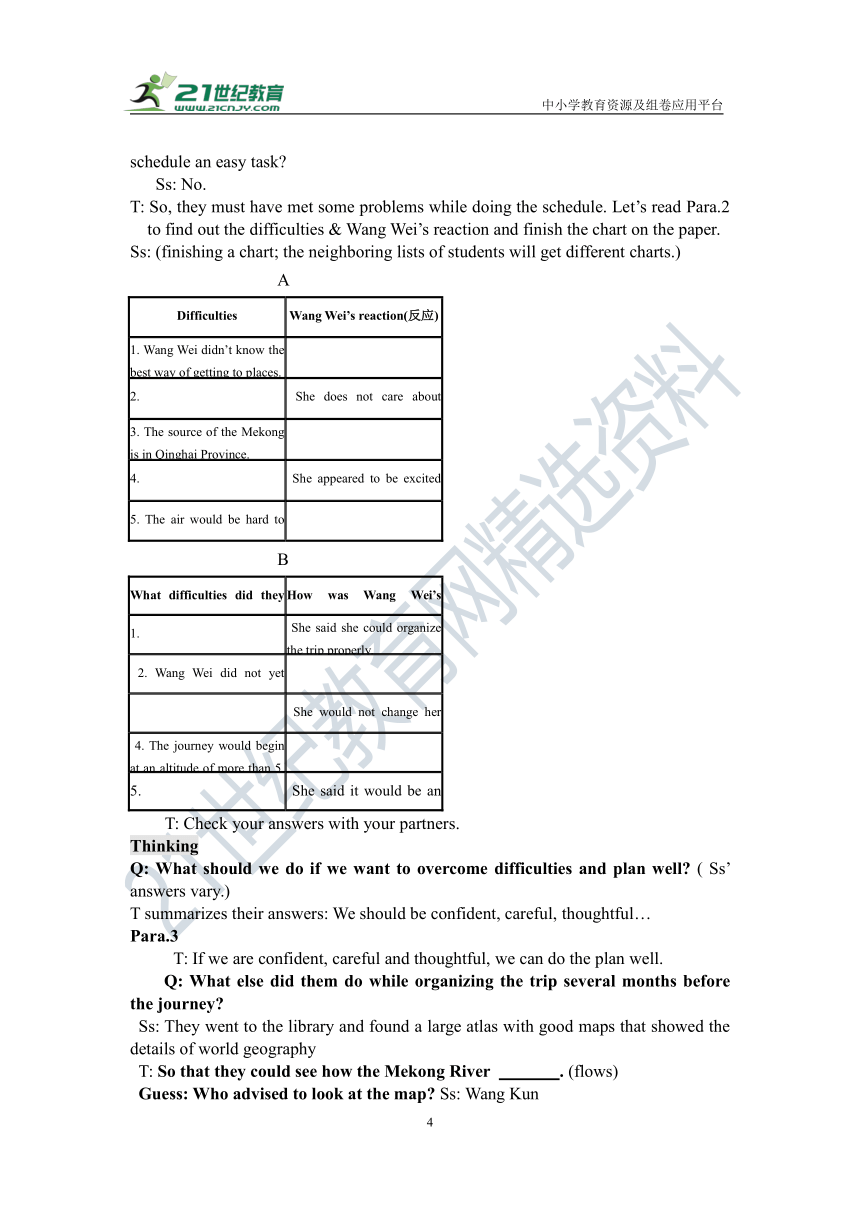人教版(2019)必修第一册 Unit 3 Sports and fitness The Dream and the Plan 读写课教学设计(表格式)
文档属性
| 名称 | 人教版(2019)必修第一册 Unit 3 Sports and fitness The Dream and the Plan 读写课教学设计(表格式) |

|
|
| 格式 | doc | ||
| 文件大小 | 583.9KB | ||
| 资源类型 | 教案 | ||
| 版本资源 | 人教版(2019) | ||
| 科目 | 英语 | ||
| 更新时间 | 2024-09-21 12:20:48 | ||
图片预览




文档简介
中小学教育资源及组卷应用平台
M1U3 Journey down the Mekong读写课教学设计
Part1 The Dream and the Plan
Teaching Objectives:
1. Ss can tell the meaning of some words, expressions and a sentence structure(persuade, schedule, stubborn, details, determined, make up one’s mind, change one’s mind, give in , the emphatic sentence structure) through reading activities and then use them while writing the journal.
2. Ss can point out the importance of a plan in achieving dreams and illustrate the difficulties in organizing the trip.
3. Ss can write a short passage of the journal with guided questions and they can develop the passage according to their understanding of the characters.
4. Ss can understand the qualities a person needs to achieve dreams and realizes that dreams takes time and needs persistence, cooperation and good preparation by reading and analyzing the details of the passage and form a positive attitude to their dreams.
Important Points:
1. Ss can write a short passage of the journal with guided questions and they can develop the passage according to their understanding of the characters.
2. Ss can understand the qualities a person needs to achieve dreams and realizes that dreams takes time and needs persistence, cooperation and good preparation by reading and analyzing the details of the passage and form a positive attitude to their dreams.
Difficult Point:
Ss can understand the qualities a person needs to achieve dreams and realizes that dreams takes time and needs persistence, cooperation and good preparation by reading and analyzing the details of the passage and form a positive attitude to their dreams.
Teaching Methods: individual reading & thinking; pair work; group discussion
Teaching Procedures
Step1 Warming up
Activity1: Enjoy a poem
Dreams
—Langston Hughes
兰斯顿·休斯
Hold fast(紧紧抓住) to dreams,
For if dreams die,
Life is a broken-winged(翅膀) bird, [w ]
That can never fly.
Hold fast to dreams,
For when dreams go,
Life is a barren(贫瘠的) field, [’b r n]
Frozen(结冰) only with snow. [’fr zn]
T: Before we go into the topic of the passage, let’s enjoy a short poem written by Langston Hughes.
Ss read the poem aloud by themselves. Then T asks them the following two Qs.
Q1: What’s the topic of the poem
Ss: Dreams.
Q2: What would life be like if there are no dreams
Ss: Life is a broken-winged bird that can never fly. Life is a barren field, frozen only with snow.
Activity2: free talk
T: So, dreams are important in our life. Everyone should have a dream. Do you have a dream
Ss: Yes.
T ask them the following 2 questions.
Q1: What’s your dream
Q2: Do you have any plans for the dream (Ss’ answers vary)
Step2 Reading activities
T: Yes, I believe all of you have your dreams. Wang Wei and Wang Kun also have a dream.
Para.1
Q1: What’s their dream
Ss: They have dreamed about taking a great bike trip.
Q2: When did they begin to have the dream Ss: Ever since middle school…
Q3: When did they get the chance to realize their dream
Ss: After graduating from college, we finally got the chance ...
Q4: How many years passed Ss: about 7 years
Q5: Did their dream come true in a day Ss: No. It takes a long time.
Insight about the dream: It takes a long time to achieve dreams sometimes, especially(尤其是) the great ones.
Further Thinking
Q6: What qualities should we have when dreams take time
Ss’ answers vary
T summarize the qualities: determined, persistent,…
Q7: What actions tell you that Wang Wei is determined and persistent
T for example she bought a bike. Can you find anything else Wang Wei did for the dream (Ss’ answer as follows)
:
Ss get general information about the Mekong River with the help of the pictures and a map.
Then T let Ss understand what Wei did was just her plan for the dream.
Para.2
T: If we want dreams come true, we should have a plan. But is planning the schedule an easy task
Ss: No.
T: So, they must have met some problems while doing the schedule. Let’s read Para.2 to find out the difficulties & Wang Wei’s reaction and finish the chart on the paper.
Ss: (finishing a chart; the neighboring lists of students will get different charts.)
A
Difficulties Wang Wei’s reaction(反应)
1. Wang Wei didn’t know the best way of getting to places.
2. She does not care about details.
3. The source of the Mekong is in Qinghai Province.
4. She appeared to be excited about it.
5. The air would be hard to breathe.
B
What difficulties did they have How was Wang Wei’s reaction(反应)
1. She said she could organize the trip properly.
2. Wang Wei did not yet look at a map.
She would not change her mind.
4. The journey would begin at an altitude of more than 5, 000 meters.
5. She said it would be an interesting experience.
T: Check your answers with your partners.
Thinking
Q: What should we do if we want to overcome difficulties and plan well ( Ss’ answers vary.)
T summarizes their answers: We should be confident, careful, thoughtful…
Para.3
T: If we are confident, careful and thoughtful, we can do the plan well.
Q: What else did them do while organizing the trip several months before the journey
Ss: They went to the library and found a large atlas with good maps that showed the details of world geography
T: So that they could see how the Mekong River . (flows)
Guess: Who advised to look at the map Ss: Wang Kun
T: That means Wang Wei accepted his advice. Both of them knew the importance of working together to achieve the dream. They knew the importance of what
Ss: teamwork.
T: Yes, we also call it cooperation. Now let’s have a look at how the river flows.
Answers: glacier; rapids; valleys; deep valleys; a waterfall; pace; bends; plains; delta.
Step3 Discussion
T: With full preparations, finally they set off for the journey.
Q1. What problem(s) they might meet while cycling
Q2. What would Wang Wei’s and Wang Kun’s attitudes facing setbacks
Q3. How would the problem(s) be solved
T: Please discuss with your group members.
Step4 Writing activity
Presentation and evaluation of Ss’ writings: List the problems and ways Ss’ have written.
problems ways
Step5 Homework
Please polish(修改) the writing and share it with your classmates.
Sharing
A dream is a flower nursed by persistence, cooperation as well as full preparation. It is sure to come out in time(适时地).
T: So let’s be a dreamer and hold fast to your dreams.
Enjoy an English song: Be You Wanna Be
(Lyric: doctor, actor, lawyer or a singer
why not president, be a dreamer
you can be just the one you wanna be
policeman, firefighter or a post man
why not something like your old man
you can be just the one you wanna be
doctor, actor, lawyer or a singer
why not president, be a dreamer
you can be just the one you wanna be…)
板书设计:
教学反思:
本次教学的亮点:
1. 本节课的文本解读以梦想为主线,贯穿本节课。虽然本单元的主要话题是旅行,但本篇文章part1的主要内容却是the dream and the plan,而plan又是因梦想而有的,所以本节课围绕着梦想及如何实现梦想为主要方向展开。
本课以关于梦想的著名短诗欣赏作课堂引入,让同学们从诗中学到人生中不能没有梦想。进而问学生有什么梦想,再引到王薇和王坤的梦想,学生通过第一段的阅读意识到梦想的实现需要时间,因此追梦人当是determined和persistent。再问王薇是否具有该种品质,并找出依据(即通过王薇为实现梦想所做的努力)。同时王薇所做的就是她按因梦想而有的计划,一步步推进的。同时,通过第二段的阅读,学生也深刻的意识到做计划并不容易,会遇到许多困难,进而引到学生思考,要做好计划、战胜困难并实现梦想,我们应当具备哪些品质(confident, careful, thoughtful)。同时通过第三段阅读,学生发现王薇和王坤为实现梦想具备合作的精神,性格互补,为实现沿湄公河骑行的梦想做好充分的准备。学生的写作输出也以实现梦想过程中他们遇见问题时将会有的态度和做出的努力为主要思考的方向,将实现梦想需要的品质借故事续写而深入学生的内心,培养学生积极向上的人生态度。最后通过板书“梦想之花”的展示和句子的分享,升华了学生对文本的理解。
2. 本节课除了阅读活动中的文本解读,写作活动的介入让学生将所学的词汇实际地运用了起来,加深了学生对所学词汇的理解;此外,学生也通过写作发表了自己的理解,写作过后学生间的作文分享、交流和讨论以及学生的作文展示增强了学生的自信心,也增进了师生间的交流。
不足之处:课堂阅读任务多,因而导致课堂给学生写作展示的时间略微不足,对学生写作的评价不够到位。由于教学的重点在文本的解读和写作实践,本节课对词汇学习的处理方式较为简单,不够深入。
1
M1U3 Journey down the Mekong读写课教学设计
Part1 The Dream and the Plan
Teaching Objectives:
1. Ss can tell the meaning of some words, expressions and a sentence structure(persuade, schedule, stubborn, details, determined, make up one’s mind, change one’s mind, give in , the emphatic sentence structure) through reading activities and then use them while writing the journal.
2. Ss can point out the importance of a plan in achieving dreams and illustrate the difficulties in organizing the trip.
3. Ss can write a short passage of the journal with guided questions and they can develop the passage according to their understanding of the characters.
4. Ss can understand the qualities a person needs to achieve dreams and realizes that dreams takes time and needs persistence, cooperation and good preparation by reading and analyzing the details of the passage and form a positive attitude to their dreams.
Important Points:
1. Ss can write a short passage of the journal with guided questions and they can develop the passage according to their understanding of the characters.
2. Ss can understand the qualities a person needs to achieve dreams and realizes that dreams takes time and needs persistence, cooperation and good preparation by reading and analyzing the details of the passage and form a positive attitude to their dreams.
Difficult Point:
Ss can understand the qualities a person needs to achieve dreams and realizes that dreams takes time and needs persistence, cooperation and good preparation by reading and analyzing the details of the passage and form a positive attitude to their dreams.
Teaching Methods: individual reading & thinking; pair work; group discussion
Teaching Procedures
Step1 Warming up
Activity1: Enjoy a poem
Dreams
—Langston Hughes
兰斯顿·休斯
Hold fast(紧紧抓住) to dreams,
For if dreams die,
Life is a broken-winged(翅膀) bird, [w ]
That can never fly.
Hold fast to dreams,
For when dreams go,
Life is a barren(贫瘠的) field, [’b r n]
Frozen(结冰) only with snow. [’fr zn]
T: Before we go into the topic of the passage, let’s enjoy a short poem written by Langston Hughes.
Ss read the poem aloud by themselves. Then T asks them the following two Qs.
Q1: What’s the topic of the poem
Ss: Dreams.
Q2: What would life be like if there are no dreams
Ss: Life is a broken-winged bird that can never fly. Life is a barren field, frozen only with snow.
Activity2: free talk
T: So, dreams are important in our life. Everyone should have a dream. Do you have a dream
Ss: Yes.
T ask them the following 2 questions.
Q1: What’s your dream
Q2: Do you have any plans for the dream (Ss’ answers vary)
Step2 Reading activities
T: Yes, I believe all of you have your dreams. Wang Wei and Wang Kun also have a dream.
Para.1
Q1: What’s their dream
Ss: They have dreamed about taking a great bike trip.
Q2: When did they begin to have the dream Ss: Ever since middle school…
Q3: When did they get the chance to realize their dream
Ss: After graduating from college, we finally got the chance ...
Q4: How many years passed Ss: about 7 years
Q5: Did their dream come true in a day Ss: No. It takes a long time.
Insight about the dream: It takes a long time to achieve dreams sometimes, especially(尤其是) the great ones.
Further Thinking
Q6: What qualities should we have when dreams take time
Ss’ answers vary
T summarize the qualities: determined, persistent,…
Q7: What actions tell you that Wang Wei is determined and persistent
T for example she bought a bike. Can you find anything else Wang Wei did for the dream (Ss’ answer as follows)
:
Ss get general information about the Mekong River with the help of the pictures and a map.
Then T let Ss understand what Wei did was just her plan for the dream.
Para.2
T: If we want dreams come true, we should have a plan. But is planning the schedule an easy task
Ss: No.
T: So, they must have met some problems while doing the schedule. Let’s read Para.2 to find out the difficulties & Wang Wei’s reaction and finish the chart on the paper.
Ss: (finishing a chart; the neighboring lists of students will get different charts.)
A
Difficulties Wang Wei’s reaction(反应)
1. Wang Wei didn’t know the best way of getting to places.
2. She does not care about details.
3. The source of the Mekong is in Qinghai Province.
4. She appeared to be excited about it.
5. The air would be hard to breathe.
B
What difficulties did they have How was Wang Wei’s reaction(反应)
1. She said she could organize the trip properly.
2. Wang Wei did not yet look at a map.
She would not change her mind.
4. The journey would begin at an altitude of more than 5, 000 meters.
5. She said it would be an interesting experience.
T: Check your answers with your partners.
Thinking
Q: What should we do if we want to overcome difficulties and plan well ( Ss’ answers vary.)
T summarizes their answers: We should be confident, careful, thoughtful…
Para.3
T: If we are confident, careful and thoughtful, we can do the plan well.
Q: What else did them do while organizing the trip several months before the journey
Ss: They went to the library and found a large atlas with good maps that showed the details of world geography
T: So that they could see how the Mekong River . (flows)
Guess: Who advised to look at the map Ss: Wang Kun
T: That means Wang Wei accepted his advice. Both of them knew the importance of working together to achieve the dream. They knew the importance of what
Ss: teamwork.
T: Yes, we also call it cooperation. Now let’s have a look at how the river flows.
Answers: glacier; rapids; valleys; deep valleys; a waterfall; pace; bends; plains; delta.
Step3 Discussion
T: With full preparations, finally they set off for the journey.
Q1. What problem(s) they might meet while cycling
Q2. What would Wang Wei’s and Wang Kun’s attitudes facing setbacks
Q3. How would the problem(s) be solved
T: Please discuss with your group members.
Step4 Writing activity
Presentation and evaluation of Ss’ writings: List the problems and ways Ss’ have written.
problems ways
Step5 Homework
Please polish(修改) the writing and share it with your classmates.
Sharing
A dream is a flower nursed by persistence, cooperation as well as full preparation. It is sure to come out in time(适时地).
T: So let’s be a dreamer and hold fast to your dreams.
Enjoy an English song: Be You Wanna Be
(Lyric: doctor, actor, lawyer or a singer
why not president, be a dreamer
you can be just the one you wanna be
policeman, firefighter or a post man
why not something like your old man
you can be just the one you wanna be
doctor, actor, lawyer or a singer
why not president, be a dreamer
you can be just the one you wanna be…)
板书设计:
教学反思:
本次教学的亮点:
1. 本节课的文本解读以梦想为主线,贯穿本节课。虽然本单元的主要话题是旅行,但本篇文章part1的主要内容却是the dream and the plan,而plan又是因梦想而有的,所以本节课围绕着梦想及如何实现梦想为主要方向展开。
本课以关于梦想的著名短诗欣赏作课堂引入,让同学们从诗中学到人生中不能没有梦想。进而问学生有什么梦想,再引到王薇和王坤的梦想,学生通过第一段的阅读意识到梦想的实现需要时间,因此追梦人当是determined和persistent。再问王薇是否具有该种品质,并找出依据(即通过王薇为实现梦想所做的努力)。同时王薇所做的就是她按因梦想而有的计划,一步步推进的。同时,通过第二段的阅读,学生也深刻的意识到做计划并不容易,会遇到许多困难,进而引到学生思考,要做好计划、战胜困难并实现梦想,我们应当具备哪些品质(confident, careful, thoughtful)。同时通过第三段阅读,学生发现王薇和王坤为实现梦想具备合作的精神,性格互补,为实现沿湄公河骑行的梦想做好充分的准备。学生的写作输出也以实现梦想过程中他们遇见问题时将会有的态度和做出的努力为主要思考的方向,将实现梦想需要的品质借故事续写而深入学生的内心,培养学生积极向上的人生态度。最后通过板书“梦想之花”的展示和句子的分享,升华了学生对文本的理解。
2. 本节课除了阅读活动中的文本解读,写作活动的介入让学生将所学的词汇实际地运用了起来,加深了学生对所学词汇的理解;此外,学生也通过写作发表了自己的理解,写作过后学生间的作文分享、交流和讨论以及学生的作文展示增强了学生的自信心,也增进了师生间的交流。
不足之处:课堂阅读任务多,因而导致课堂给学生写作展示的时间略微不足,对学生写作的评价不够到位。由于教学的重点在文本的解读和写作实践,本节课对词汇学习的处理方式较为简单,不够深入。
1
